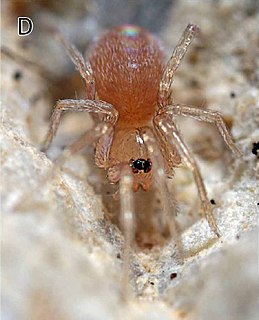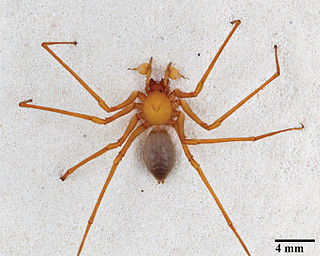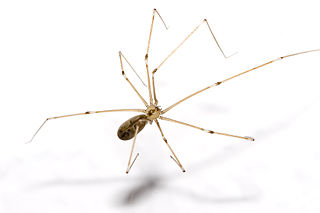
Oonopidae, also known as goblin spiders, is a family of spiders consisting of over 1,600 described species in about 113 genera worldwide, with total species diversity estimated at 2000 to 2500 species. The type genus of the family is OonopsKeyserling, 1835.

Zoropsidae, also known as false wolf spiders for their physical similarity to wolf spiders, is a family of cribellate araneomorph spiders first described by Philipp Bertkau in 1882. They can be distinguished from wolf spiders by their two rows of eyes that are more equal in size than those of Lycosidae.

Norman Ira Platnick was an American biological systematist and arachnologist. At the time of his death, he was a Professor Emeritus of the Richard Gilder Graduate School and Peter J. Solomon Family Curator Emeritus of the invertebrate zoology department of the American Museum of Natural History. A 1973 Ph.D. recipient at Harvard University, Platnick described over 1,800 species of spiders from around the world, making him the second most prolific spider taxonomist in history, behind only Eugène Simon. Until 2014 he was also the maintainer of the World Spider Catalog, a website formerly hosted by the AMNH which tracks the arachnology literature, and attempts to maintain a comprehensive list, sorted taxonomically, of every species of spider which has been formally described. In 2007 he received the International Society of Arachnology's Bonnet award, named for Pierre Bonnet, in recognition of his work on the catalog.

The Dysderoidea are a clade or superfamily of araneomorph spiders. The monophyly of the group, initially consisting of the four families Dysderidae, Oonopidae, Orsolobidae and Segestriidae, has consistently been recovered in phylogenetic studies. In 2014, a new family, Trogloraptoridae, was created for a recently discovered species Trogloraptor marchingtoni. It was suggested that Trogloraptoridae may be the most basal member of the Dysderoidea clade. However, a later study found that Trogloraptoridae was placed outside the Dysderoidea and concluded that it was not part of this clade.
The Haplogynae or haplogynes are one of the two main groups into which araneomorph spiders have traditionally been divided, the other being the Entelegynae. Morphological phylogenetic studies suggested that the Haplogynae formed a clade; more recent molecular phylogenetic studies refute this, although many of the ecribellate haplogynes do appear to form a clade, Synspermiata.

The Entelegynae or entelegynes are a subgroup of araneomorph spiders, the largest of the two main groups into which the araneomorphs were traditionally divided. Females have a genital plate (epigynum) and a "flow through" fertilization system; males have complex palpal bulbs. Molecular phylogenetic studies have supported the monophyly of Entelegynae.
Triaeris macrophthalmus is a species of spider from the family Oonopidae. It was described by Lucien Berland in 1914 and is endemic to Tanzania. In 2012, Norman I. Platnick and co-authors described the genus Triaeris as "an enigma wrapped around a mystery". They consider that most species assigned to the genus following Simon in 1890 and before 2012 do not belong to Triaeris, including T. macrophthalmus, which they suggest belongs to one of a group of related genera. As of April 2016, no alternative generic assignment has been accepted by the World Spider Catalog.

Trogloraptor is a genus of large spiders found in the caves of southwestern Oregon. It is the sole genus in the family Trogloraptoridae, and includes only one species, Trogloraptor marchingtoni. These spiders are predominantly yellow-brown in color with a maximum leg span of 3 in (7.6 cm). They are remarkable for having hook-like claws on the raptorial last segments of their legs.
Camptoscaphiella is a genus of spiders in the family Oonopidae. It was first described in 1934 by Caporiacco. As of 2017, it contains 18 Asian species.
Malagiella is a genus of spiders in the family Oonopidae. It was first described in 2011 by Ubick & Griswold. As of 2017, it contains 10 species, all from Madagascar.
Noideattella is a genus of spiders in the family Oonopidae. It was first described in 2012 by Álvarez-Padilla, Ubick & Griswold. As of 2017, it contains 13 species from Madagascar and related islands.
Tolegnaro is a genus of spiders in the family Oonopidae. It was first described in 2012 by Álvarez-Padilla, Ubick & Griswold. As of 2016, it contains 2 species, both found in Madagascar.
Volborattella is a genus of spiders in the family Oonopidae. It was first described in 2015 by Saucedo & Ubick. As of 2016, it contains 5 species, all of Madagascar.
Silhouettella is a genus of spiders in the family Oonopidae. It was first described in 1979 by Benoit. As of 2017, it contains 8 species.

Lysiteles is a genus of Asian crab spiders first described by Eugène Simon in 1895.
Sinocoelotes is a genus of spiders in the family Agelenidae. It was first described in 2016 by Zhao & Li. As of 2017, it contains 15 species from China and Thailand.

Synspermiata is a clade of araneomorph spiders, comprising most of the former "haplogynes". They are united by having simpler genitalia than other araneomorph spiders, lacking a cribellum, and sharing an evolutionary history of synspermia – a particular way in which spermatozoa are grouped together when transferred to the female.
Barbara Baehr is a research scientist, entomologist, arachnologist, and spider taxonomist. She has described over 400 new spider species, mostly from Australia. She is originally from Pforzheim, Germany.
Noideattella tsiba is a species of araneomorph spider in the family Oonopidae,. This species can only be found on the African island Madagascar. Two individual specimens were collected when the species was first discovered. The first was a male holotype which measured 1.4 mm across. The other, a female paratype measured 1.6 mm.







